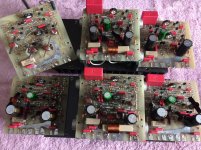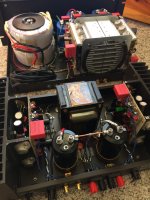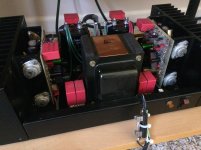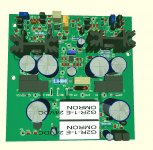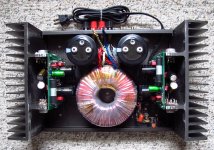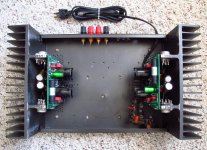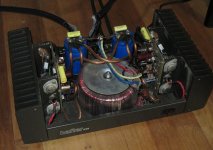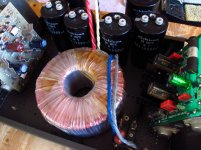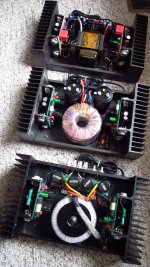PC-19 size
I have to throw my 2 cents in on these measurements. I have a small collection of older PC-19 and PC-19c boards. I just measured them all with a Brown & Sharp dial caliper (I was an aerospace machinist for 42 yrs).
The older PC-19's I have measure 4.490" square and the PC-19c's measure 4.390" square, I have several brand new PC-19c's I purchased recently on Ebay from Vintage Electron Inc. and they all measure 4.375" square all these measurements vary slightly by plus or minus .005 to .010". I don't know where someone could get 4.625" from. That's over 1/8" larger than the largest board I measured!
I have to throw my 2 cents in on these measurements. I have a small collection of older PC-19 and PC-19c boards. I just measured them all with a Brown & Sharp dial caliper (I was an aerospace machinist for 42 yrs).
The older PC-19's I have measure 4.490" square and the PC-19c's measure 4.390" square, I have several brand new PC-19c's I purchased recently on Ebay from Vintage Electron Inc. and they all measure 4.375" square all these measurements vary slightly by plus or minus .005 to .010". I don't know where someone could get 4.625" from. That's over 1/8" larger than the largest board I measured!
These are pc-6 boards, my apologies. so I would go off of the bolt pattern which is common to the later boards.
Are those calipers still even certified?
Maybe to also have the dimensions of the heat sinks that they attach to would be good also to prevent any interference, and subsequent heartache.
Are those calipers still even certified?
Maybe to also have the dimensions of the heat sinks that they attach to would be good also to prevent any interference, and subsequent heartache.
Thanks radarman, what is most important is the hole positions/sizes, since they are what is used to mount the pcb on the HS, The board outline can be flexible as long as it fits and does not interfere.
Hi al2002, I was thinking about doing the DH-200C design, I do not own a DH-220, but that would not stop me.
What would you say a reasonable price for the blank pcb to be? I was thinking about $25 USD each.
I will ask Bob Cordell what he thinks of the idea. I am sure he will say go for it, but I have to wonder how many will sell and it is a worth while for me to invest by time and $ into the development.
If scillg11 has done this DH-220C pcb design already, then I will not bother to duplicate his efforts.
Hi al2002, I was thinking about doing the DH-200C design, I do not own a DH-220, but that would not stop me.
What would you say a reasonable price for the blank pcb to be? I was thinking about $25 USD each.
I will ask Bob Cordell what he thinks of the idea. I am sure he will say go for it, but I have to wonder how many will sell and it is a worth while for me to invest by time and $ into the development.
If scillg11 has done this DH-220C pcb design already, then I will not bother to duplicate his efforts.
Just a bit of curiosity here. Since these great old amps have been out for so many years, with lots of mods... I was wondering if anyone has listened to or otherwise compared some of the different input boards available.
Specifically, has anyone compared the differences, advantages/disadvantages, and sound of these four major options.
- Stock PC-19C input boards, with caps replaced and components up to high standards.
- Musical Concepts PA-6 input boards.
- Ebay PC-1 input boards by Qua-Co.
- A DH-220C modified input board per Bob Cordell's design.
Would be interesting to hear debates/comparisons of these designs/options.
gabo
Specifically, has anyone compared the differences, advantages/disadvantages, and sound of these four major options.
- Stock PC-19C input boards, with caps replaced and components up to high standards.
- Musical Concepts PA-6 input boards.
- Ebay PC-1 input boards by Qua-Co.
- A DH-220C modified input board per Bob Cordell's design.
Would be interesting to hear debates/comparisons of these designs/options.
gabo
Just a bit of curiosity here. Since these great old amps have been out for so many years, with lots of mods... I was wondering if anyone has listened to or otherwise compared some of the different input boards available.
Specifically, has anyone compared the differences, advantages/disadvantages, and sound of these four major options.
- Stock PC-19C input boards, with caps replaced and components up to high standards.
- Musical Concepts PA-6 input boards.
- Ebay PC-1 input boards by Qua-Co.
- A DH-220C modified input board per Bob Cordell's design.
Would be interesting to hear debates/comparisons of these designs/options.
gabo
Cool, I am also interested. I just received a P-225, which I understand is a "pro" version of the 225 and essentially very similar, and it sounds great right now. I am not ready to do this sort of mod yet, but will at least look at doing it down the road. I ordered a good interconnect from Blue Jeans cables with 1/4" on one end and RCA on the other so I don't necessarily need to replace the inputs when I do mod it.
working with multiple driver boards
Interesting that people should be commenting to this effect. Comparison of modern builds of driver boards, running those amazing Hitachi MOSFETS. Many people ~may think~ of these amps as round, soft sounding and dated. Many of my friends, audio buddies would not give these amps ample consideration, even try to listen to them objectively and unbiased...
I have heard, favored (mostly) the Musical Concepts boards and ideas. John is indeed a master at component choices and voicing products... hard to surpass his effort. I have been rebuilding and optimizing the PC-19c boards, which are more stable and sound more open the the older PC6 and PC10 driver cards for Hafler 200/500. I have a broad parts compliment which works consistently for me, is very neutral and open across multiple product categories (tuners, receivers, preamps and amps) in this case amps.
The musical Concepts PC board series are all exceptional, for the money provide exemplary performance. I am glad that I sold all of my 'big solid state amps', Mark Levinson No.336, in 2011 and started building again in favor huge development's on the vintage equipment horizon. Access to modern audio grade parts, has helped to advance reviving these venerable products.
I have rebuilt all my gear with the same parts and approach on all original Hafler boards, pulled from various builds, tonally, sonically they 'are all matched' or are relative likenesses to one another. Eventually, I will gain match a few sets of front end transistors (for the oldest boards) and compare the old and new... I believe the PC19 versions out-preform PC6/PC10...
I am still at a point of break-in and putting time on the new parts of the 6 boards used in the 200, 220 and 500 amps. For note: I rebuilt a DH220 for someone... did 'all of the experimenting' with my personal 200/500 chassis.
Interesting that people should be commenting to this effect. Comparison of modern builds of driver boards, running those amazing Hitachi MOSFETS. Many people ~may think~ of these amps as round, soft sounding and dated. Many of my friends, audio buddies would not give these amps ample consideration, even try to listen to them objectively and unbiased...
I have heard, favored (mostly) the Musical Concepts boards and ideas. John is indeed a master at component choices and voicing products... hard to surpass his effort. I have been rebuilding and optimizing the PC-19c boards, which are more stable and sound more open the the older PC6 and PC10 driver cards for Hafler 200/500. I have a broad parts compliment which works consistently for me, is very neutral and open across multiple product categories (tuners, receivers, preamps and amps) in this case amps.
The musical Concepts PC board series are all exceptional, for the money provide exemplary performance. I am glad that I sold all of my 'big solid state amps', Mark Levinson No.336, in 2011 and started building again in favor huge development's on the vintage equipment horizon. Access to modern audio grade parts, has helped to advance reviving these venerable products.
I have rebuilt all my gear with the same parts and approach on all original Hafler boards, pulled from various builds, tonally, sonically they 'are all matched' or are relative likenesses to one another. Eventually, I will gain match a few sets of front end transistors (for the oldest boards) and compare the old and new... I believe the PC19 versions out-preform PC6/PC10...
I am still at a point of break-in and putting time on the new parts of the 6 boards used in the 200, 220 and 500 amps. For note: I rebuilt a DH220 for someone... did 'all of the experimenting' with my personal 200/500 chassis.
Attachments
I thought the pc-19 was very similar to the earlier boards, except for a few bypass caps, dc offset pots, and substitution of metal film resistors for the carbon ones?
I haven’t compared them, so I wouldn’t know the difference in sound between them.
My DH500 had some parts swapped also, one of the last ones was adding a bypass on the feedback cap, made a good difference.
I have also searched out the differences between the various driver boards, and always found the same thing no matter which one was discussed. It usually goes something like “it sounds great”, and “xxxxx is a great guy, he used to work at xxxx”. While this may likely be true, it doesn’t say very much at all that would tell me specifically what to expect.
I know that the Musical Concepts circuit is painfully simple with only a pair of transistors, and this has both its benefits and trade offs. I have read from others experiences with other similar circuits, who say that they are very good with the delicate timing of the sounds, yet can lack some of the detail that they are used to from more complicated designs.
I haven’t compared them, so I wouldn’t know the difference in sound between them.
My DH500 had some parts swapped also, one of the last ones was adding a bypass on the feedback cap, made a good difference.
I have also searched out the differences between the various driver boards, and always found the same thing no matter which one was discussed. It usually goes something like “it sounds great”, and “xxxxx is a great guy, he used to work at xxxx”. While this may likely be true, it doesn’t say very much at all that would tell me specifically what to expect.
I know that the Musical Concepts circuit is painfully simple with only a pair of transistors, and this has both its benefits and trade offs. I have read from others experiences with other similar circuits, who say that they are very good with the delicate timing of the sounds, yet can lack some of the detail that they are used to from more complicated designs.
It usually goes something like “it sounds great”, and “xxxxx is a great guy, he used to work at xxxx”. While this may likely be true, it doesn’t say very much at all that would tell me specifically what to expect.
hahah, Yep. That's why I posted the question. There are plenty of posts in this thread about each of those designs, sans maybe the Cordell design as I don't know anyone who actually has one of those yet. They all say just about what you noticed.
So I'm still trying to find the elusive answer to the question. I guess the answer is, I've used this one, and done that one, and like the other one.. But I'm thinking about changing the value of that cap because I think that will make it better! hahaha
gabo
I have this DH-220C design captured and in layout.
If you look at Bob's proto picture, he exceeded the original board area, but there are no obstacles to interfere, just have to jumper across the area where the heatsink fits the pcb.
Bob's DH-220C design has a lot more components on it than the original, so smt would be an option. I might do it later after a more user friendly THT version. The jfets are cheaper in the smt packages vs the TO-72-6.
Selling partially assembled smt to the DIY community can have issues. For one, the person making them would have a hard time testing an incomplete assembly. So one could be selling untested partial assemblies. I would shun away from such activity.
This DH-220C is a tight THT layout to get into the existing pcb area. Need to use some miniature SFR16 type resistors in some areas to make it fit.
If you look at Bob's proto picture, he exceeded the original board area, but there are no obstacles to interfere, just have to jumper across the area where the heatsink fits the pcb.
Bob's DH-220C design has a lot more components on it than the original, so smt would be an option. I might do it later after a more user friendly THT version. The jfets are cheaper in the smt packages vs the TO-72-6.
Selling partially assembled smt to the DIY community can have issues. For one, the person making them would have a hard time testing an incomplete assembly. So one could be selling untested partial assemblies. I would shun away from such activity.
This DH-220C is a tight THT layout to get into the existing pcb area. Need to use some miniature SFR16 type resistors in some areas to make it fit.
I was overlooking the developing part when I spoke of using smd parts.
The test fixture would be very complicated unless the electrolytic parts were to be the outer most components, where the holes could be picked up more readily on a fixture. Probably way overkill thinking for a niche item. I’ve seen medical projects held for a long time due to inadequate fixtures like that, probably not something appropriate for this!
Hmm...
That’s a nice looking looking board! It’s a shame you don’t have an amp to try it on.
The test fixture would be very complicated unless the electrolytic parts were to be the outer most components, where the holes could be picked up more readily on a fixture. Probably way overkill thinking for a niche item. I’ve seen medical projects held for a long time due to inadequate fixtures like that, probably not something appropriate for this!
Hmm...
That’s a nice looking looking board! It’s a shame you don’t have an amp to try it on.
It's great that you guys are making progress on the DH-220C boards, but the question remains...
What are the differences, pros/cons in the DH-220C design and the designs in the musical concepts PA-6 boards, the Qua-Co PA-1 boards, the updated PC-19C boards.
From reading posts, there seems to be a consensus that the MC PA-6 mods sound better than the original PC-19C. But in my mind it's just a little to pricey for a DIY'er.
There also seems to be a lot of info stating that the cascode design is a better option, but I haven't heard anyone specifically evaluating the PC-1 boards on ebay from Qua-Co. Which is a cascode design and there is good info that Qua-Co used to work for Hafler and has a lot of excellent experience.
Which brings us to the DH-220C design. I know Bob Cordell is an expert, has written an excellent book (and I'm patiently waiting for rev 2!). So that design is going to be solid. But is it an improvement on the MC PA-6 or Qua-Co PC-1? If we can get boards and schematics it has the possibility of being in the right price range so that might be a great option.
I agree with some of the comments above that a partially populated board is hard to sell and probably isn't' a good way to go. Either a raw board with parts lists and schematic or a fully populated board are the only logical options, at least in my mind.
To review the options.
- Upgrade caps and parts on the PC-19C. The price for this varies depending what you replace, but nominally I would put the price of this ~$50. The design is proven and the sound is quite good. If your boards are damaged, you can buy new boards on ebay for a reasonable price.
- PA-6 from MC. The lowest kit price for this is $599 with prices for some upgrades over $2000. Geez, you can buy some really great, brand new, modern amps for less. So this seems to be a non-starter, it's just too expensive (my opinion).
- PC-1 on ebay from Qua-Co. This is actually an interesting deal. On sale right now for $225. This includes two new boards (one for each channel), all the parts to stuff it, instructions and schematics. So if you consider a raw board price in the ~30 range, you have $60 worth of boards. If you consider $60-$70 each for parts on the boards, you have maybe another $140. So that's $200. So the guy isn't making much profit and his price is actually about right. I just haven't heard anything about his design or the sound of an amp with his mods.
So is this design as good as the MC PA-6? Better or equal to the PC-19C? Is the Bob Cordell design superior to all of these?
Maybe I should just update my PC-19 with new parts and build a "honey badger," while listening to tunes pumped out by my Hafler!
gabo
What are the differences, pros/cons in the DH-220C design and the designs in the musical concepts PA-6 boards, the Qua-Co PA-1 boards, the updated PC-19C boards.
From reading posts, there seems to be a consensus that the MC PA-6 mods sound better than the original PC-19C. But in my mind it's just a little to pricey for a DIY'er.
There also seems to be a lot of info stating that the cascode design is a better option, but I haven't heard anyone specifically evaluating the PC-1 boards on ebay from Qua-Co. Which is a cascode design and there is good info that Qua-Co used to work for Hafler and has a lot of excellent experience.
Which brings us to the DH-220C design. I know Bob Cordell is an expert, has written an excellent book (and I'm patiently waiting for rev 2!). So that design is going to be solid. But is it an improvement on the MC PA-6 or Qua-Co PC-1? If we can get boards and schematics it has the possibility of being in the right price range so that might be a great option.
I agree with some of the comments above that a partially populated board is hard to sell and probably isn't' a good way to go. Either a raw board with parts lists and schematic or a fully populated board are the only logical options, at least in my mind.
To review the options.
- Upgrade caps and parts on the PC-19C. The price for this varies depending what you replace, but nominally I would put the price of this ~$50. The design is proven and the sound is quite good. If your boards are damaged, you can buy new boards on ebay for a reasonable price.
- PA-6 from MC. The lowest kit price for this is $599 with prices for some upgrades over $2000. Geez, you can buy some really great, brand new, modern amps for less. So this seems to be a non-starter, it's just too expensive (my opinion).
- PC-1 on ebay from Qua-Co. This is actually an interesting deal. On sale right now for $225. This includes two new boards (one for each channel), all the parts to stuff it, instructions and schematics. So if you consider a raw board price in the ~30 range, you have $60 worth of boards. If you consider $60-$70 each for parts on the boards, you have maybe another $140. So that's $200. So the guy isn't making much profit and his price is actually about right. I just haven't heard anything about his design or the sound of an amp with his mods.
So is this design as good as the MC PA-6? Better or equal to the PC-19C? Is the Bob Cordell design superior to all of these?
Maybe I should just update my PC-19 with new parts and build a "honey badger," while listening to tunes pumped out by my Hafler!
gabo
Hi gabo,
maybe this document helps a little more. It' s Bob's presentation from Burning Amp Festival 2016. I think, it would give you some more information.
For me the Qua-Co Design is unknown from performance. The updates for $500 are slightly overprized. A simple way to go is upgrading your existing boards with new Caps (Panasonic FC FR, Nichicon Muse for bipolar) the resistors with Dale CMF55 and MKP capacitors and MICA capacitors. And finally better wiring.
BR
Günni
maybe this document helps a little more. It' s Bob's presentation from Burning Amp Festival 2016. I think, it would give you some more information.
For me the Qua-Co Design is unknown from performance. The updates for $500 are slightly overprized. A simple way to go is upgrading your existing boards with new Caps (Panasonic FC FR, Nichicon Muse for bipolar) the resistors with Dale CMF55 and MKP capacitors and MICA capacitors. And finally better wiring.
BR
Günni
Attachments
I doubt that many if not anyone has evaluated all these DH-220 options. Certainly not me, since I do not own a DH-220C. If I finalize & test out the DH-220C design, it will have to be with SemeLab lateral mosfets.
BobC made his points about his design improvements and reasons for his choices in the presentation. I do not recall him saying anything about sound quality. Some designers shy away from these comparisons and rely more on testing than sound quality opinions. Bob's DH-220C re-design is a away of marketing the Linear Systems jfets, when they introduced the lsk489,lsj689 devices a few years back.
I am messing with the DH-220C re-design for something fun to do.
You got that right, with your PC-1 cost analysis, the market is very small, hard to sell this stuff. Also the seller losses out on eBay and PayPal charges, which is around the 7-8% range. The finer details of the hidden eBay raquette.
BobC made his points about his design improvements and reasons for his choices in the presentation. I do not recall him saying anything about sound quality. Some designers shy away from these comparisons and rely more on testing than sound quality opinions. Bob's DH-220C re-design is a away of marketing the Linear Systems jfets, when they introduced the lsk489,lsj689 devices a few years back.
I am messing with the DH-220C re-design for something fun to do.
You got that right, with your PC-1 cost analysis, the market is very small, hard to sell this stuff. Also the seller losses out on eBay and PayPal charges, which is around the 7-8% range. The finer details of the hidden eBay raquette.
"updating" my original DH220
I have been thinking about this, what I would do to my original 220 for over 35 years, last listened to it in 2011, against my Mark Levinson No.336... sold both it and my No.29, the "Hafler' based amps 'are good enough" ~that good~ honestly sounded more open and got out of the way of the music better my other amps, nearly all other amps. In spite of a love affair, an affinity and deep understanding of this amps series
I used this old amp to learn and model, installed multiples of Musical Concepts / Hafler driver board mods, versions they used offer as kits. This particular one has the Beta Matched front end transistors... Is / was an amp slayer in the day. I used alternatively with NYAL Futterman OTL-3 amps... The Hafler, for the every day use (mostly) Summer amps; In the day I would have friends bring over the Big Boy Levinsons, Rowlands, Audio Research behemoths along side this modest Hafler... it unflinchingly held its own, I always had a clear mirror to adjusting and adapting performance.
I used Monster Cable 10g (it is what we had) for the DC runs, twisted Sound Connections / Vampire Wire to speaker out. I gutted the chassis, kept my original Tiffany RCA and 5-way BP, captive AC power cord and power switch. Probably will wire DC in larger Gauge solid core.
Image 5: three amps in a line up... At the back stock'ish MM220. The middle is my original MC220, as I imagine it. working to fit and layout the parts. The 62.5mm caps ~plus~ the toroid makes for a tight chassis ...power supply wise... 4 caps, as dual mono on image 4 are sadly out of the question. My principal challenge is the Left Channel side electrolytic, is (either) near - speaker terminal or the Driver stage heat sink, ideally 2mm away from each ...and... the other is positioning the capacitor mounting brackets, where the 6 bolt positions do not create havoc to nearby things, squished together... not my ideal. the 62.5mm, 22,000 mfd, way outperform the 51mm stock size, enough to warrant the extra work on the chassis pan.
I will compare the middle amp, to the 3rd (bottom) amp with the exemplary Jensen 4-pole caps... frankly, I am trying / working to mirror the performance of the 4-pole to the point to point wired 'can type' power supply, with both using the [4 year old] Musical Concepts PA4 driver boards, I have owned and used them as a much trusted reference for building. Mostly for modeling power supplies. (another story)
I have been thinking about this, what I would do to my original 220 for over 35 years, last listened to it in 2011, against my Mark Levinson No.336... sold both it and my No.29, the "Hafler' based amps 'are good enough" ~that good~ honestly sounded more open and got out of the way of the music better my other amps, nearly all other amps. In spite of a love affair, an affinity and deep understanding of this amps series
I used this old amp to learn and model, installed multiples of Musical Concepts / Hafler driver board mods, versions they used offer as kits. This particular one has the Beta Matched front end transistors... Is / was an amp slayer in the day. I used alternatively with NYAL Futterman OTL-3 amps... The Hafler, for the every day use (mostly) Summer amps; In the day I would have friends bring over the Big Boy Levinsons, Rowlands, Audio Research behemoths along side this modest Hafler... it unflinchingly held its own, I always had a clear mirror to adjusting and adapting performance.
I used Monster Cable 10g (it is what we had) for the DC runs, twisted Sound Connections / Vampire Wire to speaker out. I gutted the chassis, kept my original Tiffany RCA and 5-way BP, captive AC power cord and power switch. Probably will wire DC in larger Gauge solid core.
Image 5: three amps in a line up... At the back stock'ish MM220. The middle is my original MC220, as I imagine it. working to fit and layout the parts. The 62.5mm caps ~plus~ the toroid makes for a tight chassis ...power supply wise... 4 caps, as dual mono on image 4 are sadly out of the question. My principal challenge is the Left Channel side electrolytic, is (either) near - speaker terminal or the Driver stage heat sink, ideally 2mm away from each ...and... the other is positioning the capacitor mounting brackets, where the 6 bolt positions do not create havoc to nearby things, squished together... not my ideal. the 62.5mm, 22,000 mfd, way outperform the 51mm stock size, enough to warrant the extra work on the chassis pan.
I will compare the middle amp, to the 3rd (bottom) amp with the exemplary Jensen 4-pole caps... frankly, I am trying / working to mirror the performance of the 4-pole to the point to point wired 'can type' power supply, with both using the [4 year old] Musical Concepts PA4 driver boards, I have owned and used them as a much trusted reference for building. Mostly for modeling power supplies. (another story)
Attachments
Last edited:
- Home
- Amplifiers
- Solid State
- Hafler DH-200/220 Mods
